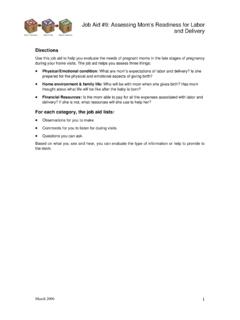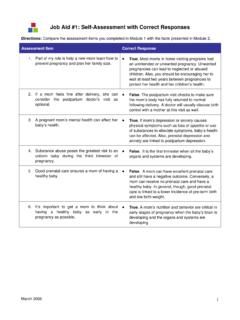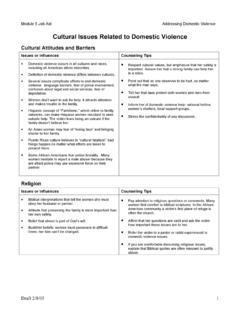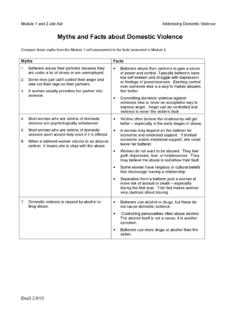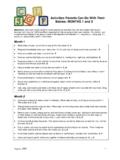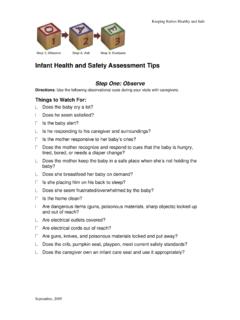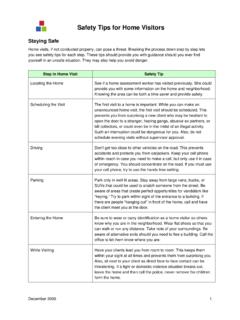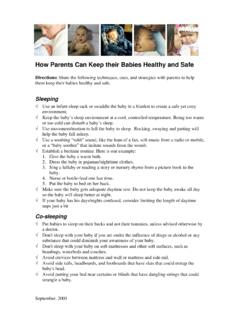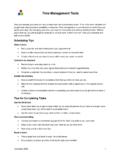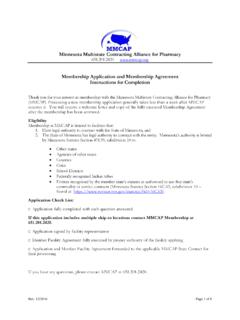Transcription of SIDS prevention guidelines - Healthy Families …
1 October 2005 Keeping Babies Healthy and Safe sids prevention guidelines Directions: review the key findings from a 2005 American Academy of Pediatrics (AAP) article that addresses several issues related to sids . Then, use the bulleted list of recommendations with parents to help them reduce the risk of sids for their babies. AAP Findings The AAP no longer recognizes side sleeping as a reasonable alternative to back sleeping. Studies have found that the side sleep position is unstable and increases the chances of the infant rolling onto his or her stomach. Every caregiver should put babies on their backs to sleep. Bed sharing is not recommended during sleep. Infants may be brought into bed for nursing or comforting, but should be returned to their own crib or bassinet when the parent is ready to return to sleep. However, there is growing evidence that room sharing (infant sleeping in a crib in parent s bedroom) is associated with a reduced risk of sids .
2 The AAP recommends a separate but proximate sleeping environment. Research now indicates an association between pacifier use and a reduced risk of sids . The AAP recommends the use of pacifiers at nap time and bedtime throughout the first year of life. The evidence that pacifier use inhibits breastfeeding or causes later dental complications is not compelling enough to discredit the recommendation. However, caregivers should delay introducing a pacifier to breastfed infants for one month of age to ensure that breastfeeding is firmly established. In addition, if the infant refuses the pacifier, it should not be forced. There is a slight increased risk of ear infections associated with pacifier use, but the incidence of ear infection is generally lower in the first year of life, especially the first six months, when the risk of sids is the highest. The following have been consistently identified as risk factors for sids : prone (lying on stomach) sleep position, sleeping on a soft surface, maternal smoking during pregnancy, overheating, late or no prenatal care, young maternal age, preterm birth and/or low birth weight and male gender.
3 Consistently higher rates of sids are found in black and American Indian/Alaska Native children - two to three times the national average. AAP Recommendations Place infants on their backs for every sleep. Use a firm sleep surface. A firm crib mattress, covered by a sheet, is the recommended sleeping surface. Keep soft objects and loose bedding out of the crib. Pillows, quilts, comforters, sheepskins, stuffed toys and other soft objects should be kept out of an infant s sleeping environment. October 2005 Keeping Babies Healthy and Safe Do not smoke during pregnancy. Also avoiding an infant s exposure to second-hand smoke is advisable for numerous reasons in addition to sids risk. A separate but proximate sleeping environment is recommended such as a separate crib in the parent s bedroom. Bed sharing during sleep is not recommended. Consider offering a pacifier at nap time and bedtime.
4 The pacifier should be used when placing infant down for sleep and not be reinserted once the infant falls asleep. Avoid overheating. The infant should be lightly clothed for sleep, and the bedroom temperature should be kept comfortable for a lightly clothed adult. Avoid commercial devices marketed to reduce the risk of sids . Although various devices have been developed to maintain sleep position or reduce the risk of rebreathing, none have been tested sufficiently to show efficacy or safety. Do not use home monitors as a strategy to reduce the risk of sids . There is no evidence that use of such home monitors decreases the risk of sids . Avoid the development of a flat back to the infant s head. Encourage tummy time. Place the infant to sleep with the head to one side for a week and then changing to the other. Avoid having the infant spend excessive time in car-seat carriers and bouncers which could also create a flat back to the infant s head.
5 Assure that others caring for the infant (child care provider, relative, friend, babysitter) are aware of these recommendations.
